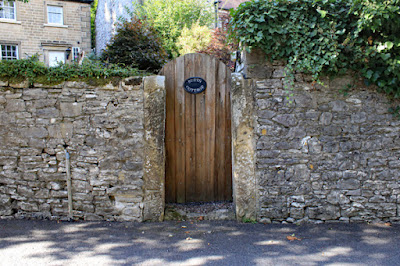 |
| The entrance steps to All Saints churchyard |
Continuing my afternoon in Bakewell, to photograph its historic architecture as part of the British Listed Buildings Photo Challenge, I continued up South Church Street until I reached Butts Road and went to find the ‘Garden Wall and Gate Piers at Butts Cottage and Woodside Cottage’.
 |
| The garden wall and gate piers at Butts Cottage |
When living in Bakewell, during which time I assessed the RIGS (Regionally Important Geological Sites) in the Peak District Park National Park – for their Geotourism value - completed a 3 month contract at the Sheffield Museum Natural History Centre and drove everyday to Mansfield to cut various stones in the Gregory's Quarry, I passed these very many times on the way to town and back from Catcliffe Cottages without ever noticing them.
The combination of limestone for walling and gritstone for dressings, which includes gate piers as well as quoins and door and window surrounds, is quite typical of the vernacular architecture that can be seen in the part of the Peak District National Park that is known as the White Peak.
Returning to South Church Street, the next building on my list was Ivy House, to photograph its railings. Historic England date it to the mid C17, but it has a remodelled facade that a rainwater head suggests was completed in 1743. It is again built in limestone with gritstone dressings, but the original stone slate roof has been replaced by Welsh slate.
A little further up the road, the early C19 Church View (Nunber 9), which constitutes a pair of houses, is built with dressed Millstone Grit and does not have quoins, as previously seen in some of the houses along Matlock Street and King Street.
I then crossed the road to the steps to All Saints church, which I had to photograph along with the retaining walls to the churchyard. The front wall to the steps is gritstone, as are the ‘Gothic Revival piers with cusped sunken-panel faces and gabled caps with fleur-de-lys cresting’, but the retaining wall is built with limestone.
Crossing back over South Church Road to Butts View, a narrow private road that I had never encountered before, my task was to photograph Spring Cottage and its separately listed garden wall, Butts View and then Number One and Butts Cottage.
As occasionally happens, the numbering and names that I had copied from the Historic England listing description are a little bit confusing and Number One and Butts Cottage is also included in the listing for Nos. 17 and 19 South Church Street. It seems that I actually missed out Butts View, which is actually part of a pair with Spring Cottage, but I won’t lose any sleep over it.
Making my way further up South Church Street, after once more crossing it, I photographed Holly House, which is built with tooled gritstone walling with ashlar dressings and a concrete tile roof that I didn’t notice at the time.








No comments:
Post a Comment